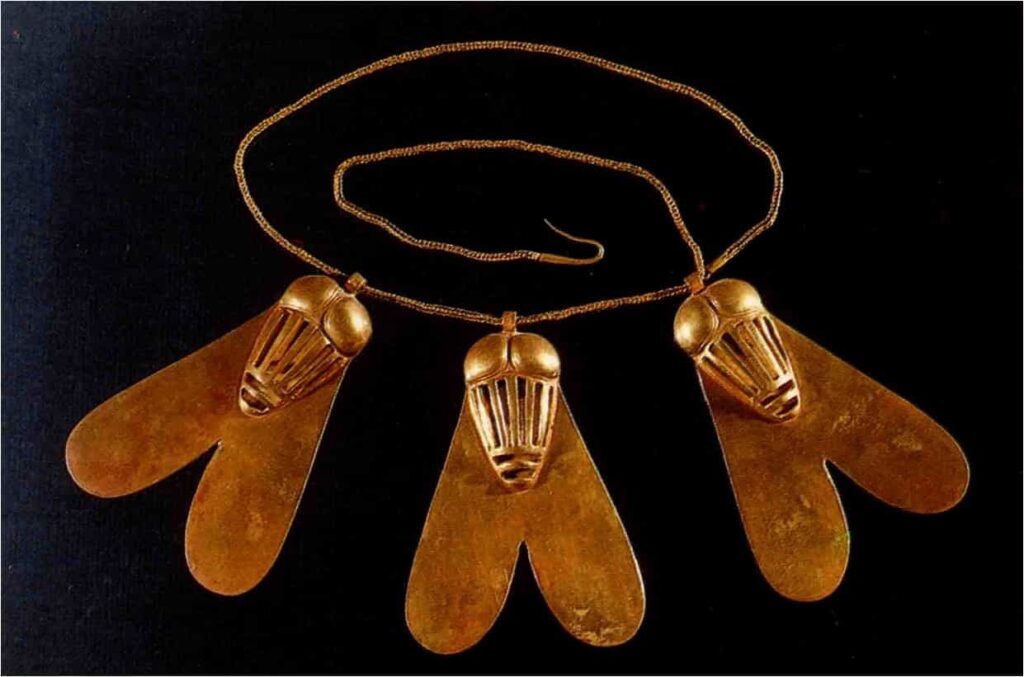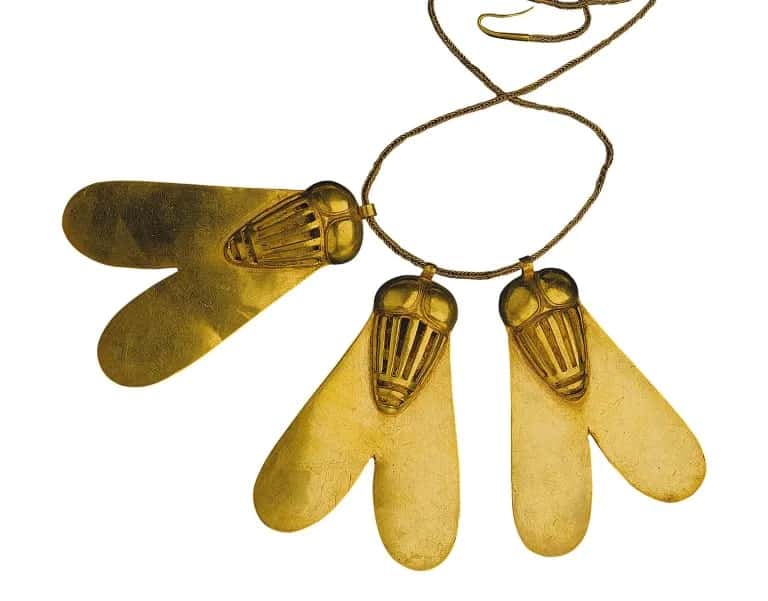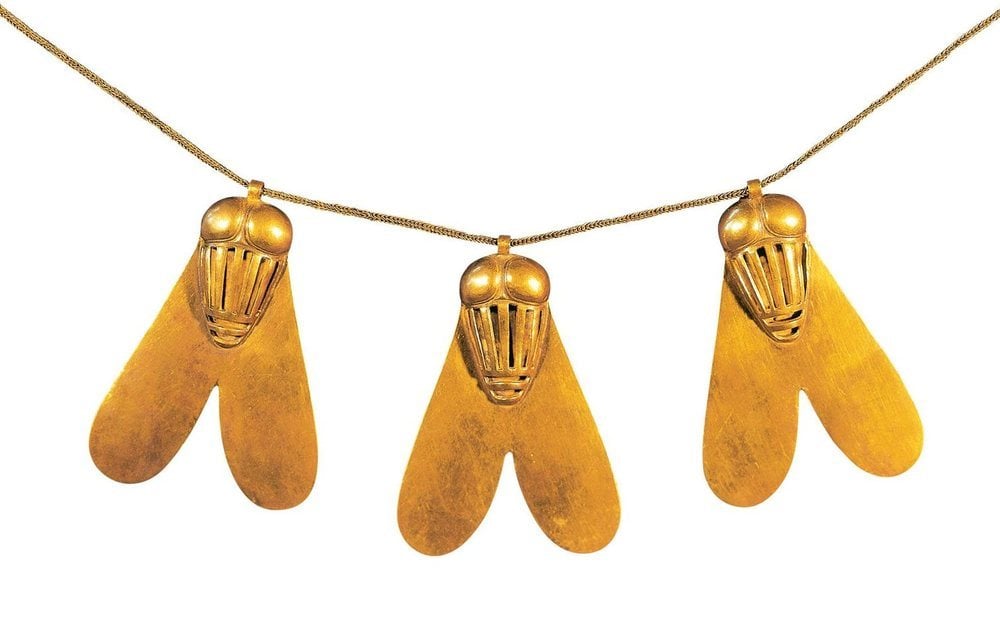
The fly had a very special meaning in ancient Egypt. It was famously featured on the necklace found in the tomb of Queen Ahhotep, which was adorned with gold flies. In this article, we will discuss the meaning of the fly in Egypt, why there were necklaces with gold flies, and why Queen Ahhotep had one of them.
The Meaning of the Fly in Ancient Egypt
In ancient Egypt, the fly had a prophylactic and protective value. During the pre-dynastic period, there were stone amulets in the shape of a fly, as well as numerous ceramic paintings of flies.
Later, during the New Kingdom (1550-1070 BC), the Decoration of the Order of the Golden Fly or the Pain Fly appeared. It was the highest decoration that a pharaoh gave to his bravest soldiers.
Normally made of gold, although some have been found in silver, the meaning of the award was that, just as the fly bites animals and persists in annoying them until the end, the soldiers attacked their enemies without rest.
Courage, strength, mastery, insistence, and tenacity were the greatest attributes of these soldiers. In fact, there was a soldier from the time of Thutmose I who received up to six flies for his courage. Flies also appeared in the tombs of various wives of Thutmose III, although the reason for this is unknown.
The Golden Fly Necklace of Queen Ahhotep I
Queen Ahhotep was rewarded by Ahmose with a beautiful necklace full of flies for her bravery in the war against the Hyksos. Ahhotep’s role must have been very important, as this accolade was normally only received by men. In fact, there is no evidence that any other Egyptian queen received this necklace.
The three pendants on the necklace are in the shape of stylized flies with two bulging eyes and openwork bodies. They are made from extremely fine gold, with the smooth wings and chased bodies giving the impression of a living insect. The pendants are hung from short, finely linked chains that attach to the rings fixed between their protruding eyes.
The intricate crafting of the flies is a testament to the skill of ancient Egyptian goldsmiths. The wings of the flies are made from sheet gold upon which a second piece, hammered into a mold to represent the head and eyes, has been soldered. Slots were then cut along the back to represent the body of the fly. As the wearer moves, the pendants are said to flash, capturing the iridescence of a living insect.
The necklace, dating back to the Second Intermediate Period, 17th Dynasty, is estimated to have been created around 1560-1530 BC. It was excavated by A. Mariette in 1859 at Dra’ Abu el-Naga’, West Thebes and is now on display at the Luxor Museum.
The Golden Fly Necklace of Queen Ahhotep I is not only a stunning piece of ancient jewelry, but also a symbol of courage, valor, and the enduring legacy of one of Egypt’s most remarkable queens.

The Golden Fly Necklace of Queen Ahhotep I



News
Unveiling the Ingenious Engineering of the Inca Civilization: The Mystery of the Drill Holes at the Door of the Moon Temple in Qorikancha – How Were They Made? What Tools Were Used? What Secrets Do They Hold About Inca Technology? And What Does Their Discovery Mean for Our Understanding of Ancient Construction Methods?
In the heart of Cusco, Peru, nestled within the ancient Qorikancha complex, lies a fascinating testament to the advanced engineering prowess of the Inca civilization. Here, archaeologists have uncovered meticulously angled drill holes adorning the stone walls of the Door…
Unveiling the Sun Stone: Aztec Relic from the Reign of Moctezuma II (1502-1520) – What Secrets Does It Hold? How Was It Used? What Symbolism Does It Carry? And What Does Its Discovery Reveal About Aztec Culture?
In the heart of Mexico City, amidst the bustling Plaza Mayor, lies a silent sentinel of ancient wisdom and artistry – the Sun Stone. This awe-inspiring artifact, dating back to the reign of Moctezuma II in the early 16th century,…
Uncovering the Past: Rare 1,000-Year-Old Copper Arrowhead Found – Who Crafted It? What Was Its Purpose? How Did It End Up Preserved for So Long? And What Insights Does It Offer into Ancient Societies?
In the realm of archaeology, every discovery has the potential to shed light on our shared human history. Recently, a remarkable find has captured the attention of researchers and enthusiasts alike – a rare, 1,000-year-old copper arrowhead. This ancient artifact…
Unveiling History: The Discovery of an Old Sword in Wisła, Poland – What Secrets Does It Hold? Who Owned It? How Did It End Up There? And What Does Its Discovery Mean for Our Understanding of the Past?
In a remarkable archaeological find that has captured the imagination of historians and enthusiasts alike, an old sword dating back to the 9th-10th century AD has been unearthed in Wisła (Vistula River) near Włocławek, Poland. This discovery sheds light on the rich…
Unveiling the Hidden Riches: Discovering the Treasure Trove of a Notorious Pirate – Who Was the Pirate? Where Was the Treasure Found? What Historical Insights Does It Reveal? And What Challenges Await Those Who Seek to Uncover Its Secrets?
A group of divers said on May 7 that they had found the treasure of the infamous Scottish pirate William Kidd off the coast of Madagascar. Diver Barry Clifford and his team from Massachusetts – USA went to Madagascar and…
Excavation Update: Archaeologists Unearth Massive Cache of Unopened Sarcophagi Dating Back 2,500 Years at Saqqara – What Secrets Do These Ancient Tombs Hold? How Will They Shed Light on Ancient Egyptian Burial Practices? What Mysteries Await Inside? And Why Were They Buried Untouched for Millennia?
Egypt has unearthed another trove of ancient coffins in the vast Saqqara necropolis south of Cairo, announcing the discovery of more than 80 sarcophagi. The Tourism and Antiquities Ministry said in a statement that archaeologists had found the collection of colourful, sealed caskets which were…
End of content
No more pages to load











